
In industrial settings, indoor air quality is a critical factor in process efficiency, product quality, and worker safety. Understanding psychrometrics – the science of moist air properties – is the key to mastering your industrial environment. Psychrometric calculations help you precisely analyze factors like temperature, humidity, and airflow. These calculations are part of the data that is used to choose the necessary components and create the best design for your industrial ventilation system.
At Eldridge, our team has expertise in designing ventilation systems across a wide range of industries. Whether you’re building a brand-new facility or retrofitting an existing one, we can help you optimize your ventilation system using accurate psychrometric analysis. Contact us today to schedule a technical assessment with our team.
Psychrometrics in Simple Terms
Psychrometrics is a field of engineering focused on understanding and manipulating the properties of moist air. Air always contains some level of water vapor, and those properties change depending on factors like temperature and pressure. Our calculations involve using mathematical formulas and relationships to determine specific characteristics of the air inside your facility.
Understanding these properties and how they impact each other allows us to design a ventilation system that can achieve the specific indoor air conditions you need. The properties of air we assess include:
- Dry-bulb temperature (DBT): The standard temperature measurement using a thermometer where the bulb is kept dry.
- Wet-bulb temperature (WBT): The temperature measured with a thermometer covered in a water-soaked cloth. The difference between WBT and DBT tells you about air dryness.
- Relative humidity (RH): A percentage showing how much moisture the air holds compared to how much it could hold at that temperature.
- Dew point temperature: The temperature at which air becomes fully saturated, and water vapor starts to condense.
- Humidity ratio/absolute humidity: The actual mass of water vapor present in a given volume of air.
- Enthalpy: The total heat content of the air, considering both sensible (temperature-related) and latent (moisture-related) heat.
- Specific volume: How much space a certain amount of air occupies.
Plotting Your Psychrometric Chart
A psychrometric chart is a graphical tool that helps visualize the relationships between temperature, humidity, and other air properties. While the underlying formulas might seem complex, the psychrometric chart simplifies calculations by letting us visually navigate the relationships between your different air properties.
The chart has two main axes:
- Dry-bulb temperature (DBT): This runs horizontally, representing the air temperature measured by a regular thermometer.
- Humidity ratio (absolute humidity): This goes vertically, showing the actual amount of moisture present in the air.
Diagonally across the chart are curved lines representing relative humidity (RH). Higher on these curves signifies higher RH, meaning the air is closer to its saturation point.
The chart also includes a bold line called the saturation curve. This line marks the point at which the air reaches 100% RH and condensation occurs.
How Calculations Translate to Ventilation System Design
Psychrometric calculations aren’t just abstract numbers. They translate directly to the efficiency, reliability, and safety of your industrial ventilation system.
Ventilation Optimization
Understanding the heat and moisture content of the air is vital for sizing fans, ducts, and other system components. Psychrometrics let you:
- Calculate heat loads from processes or equipment to determine the airflow needed for cooling.
- Determine the right air exchange rates to remove harmful contaminants.
- Evaluate a system’s energy efficiency and identify potential improvements.
Process Control
Many industrial processes are highly sensitive to humidity and temperature. Psychrometric calculations are crucial for:
- Calculating the air’s moisture removal capacity for drying operations.
- Adding moisture to maintain specific conditions.
- Manufacturing areas that require tight temperature and humidity ranges for product consistency or equipment stability.
Worker Comfort and Safety
Air quality impacts your team as much as it does your processes. Psychrometrics enables you to:
- Prevent condensation, which leads to mold and structural damage.
- Manage thermal comfort to prevent heat stress and productivity loss.
- Design systems to control hazardous gas concentrations and ensure safe working environments.
Expertise in Industrial Ventilation System Design
Calculating your psychrometrics empowers us to create optimal indoor air conditions for your operations, equipment, and people. We have decades of experience in tackling industrial ventilation challenges with technical expertise.
Whether you’re facing productivity issues, product quality concerns, or health and safety risks related to air quality, our team can perform an in-depth analysis of your facility. Using these insights, we’ll design a custom ventilation system tailored specifically to your needs. Contact us today to schedule an assessment.
